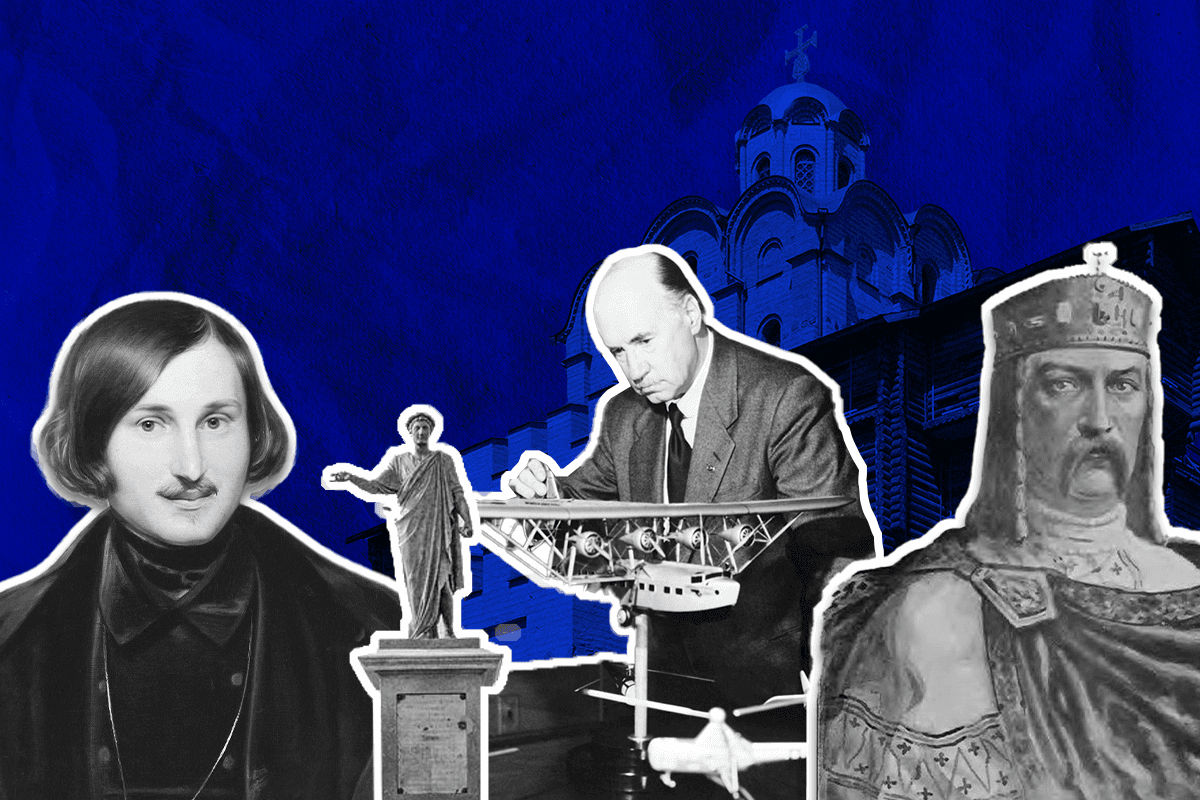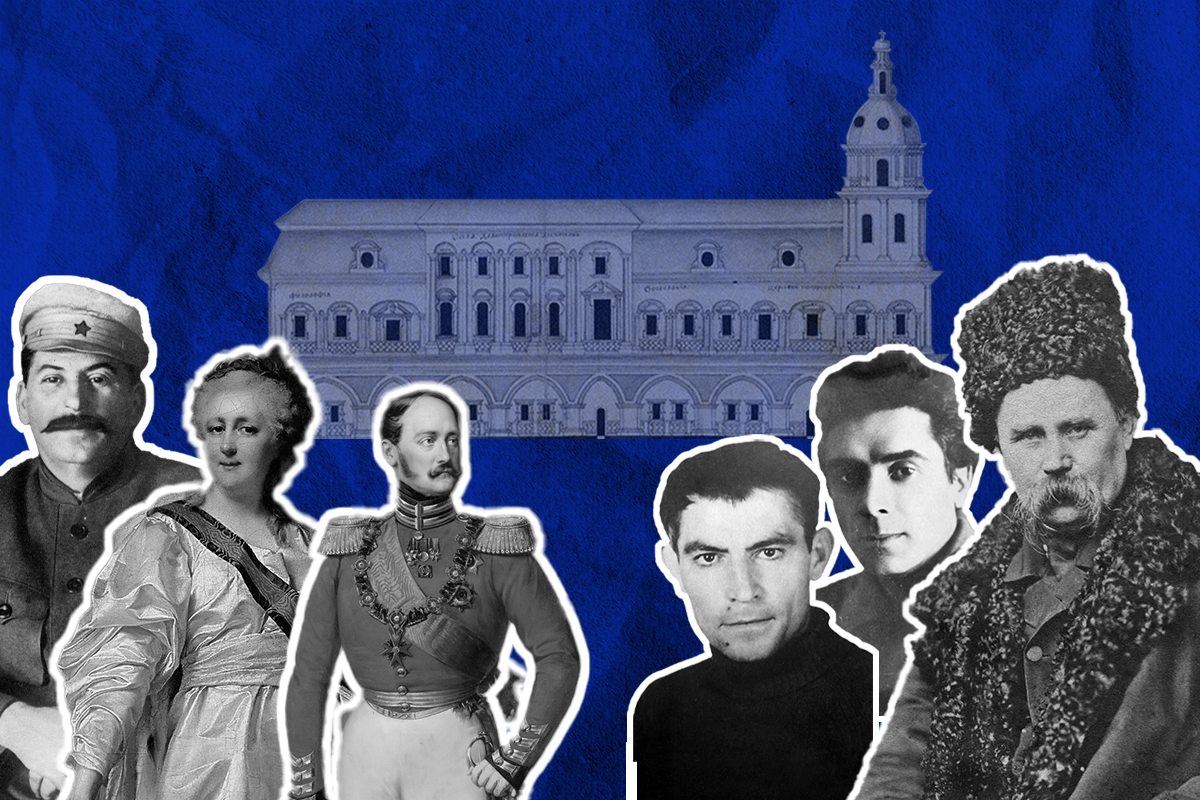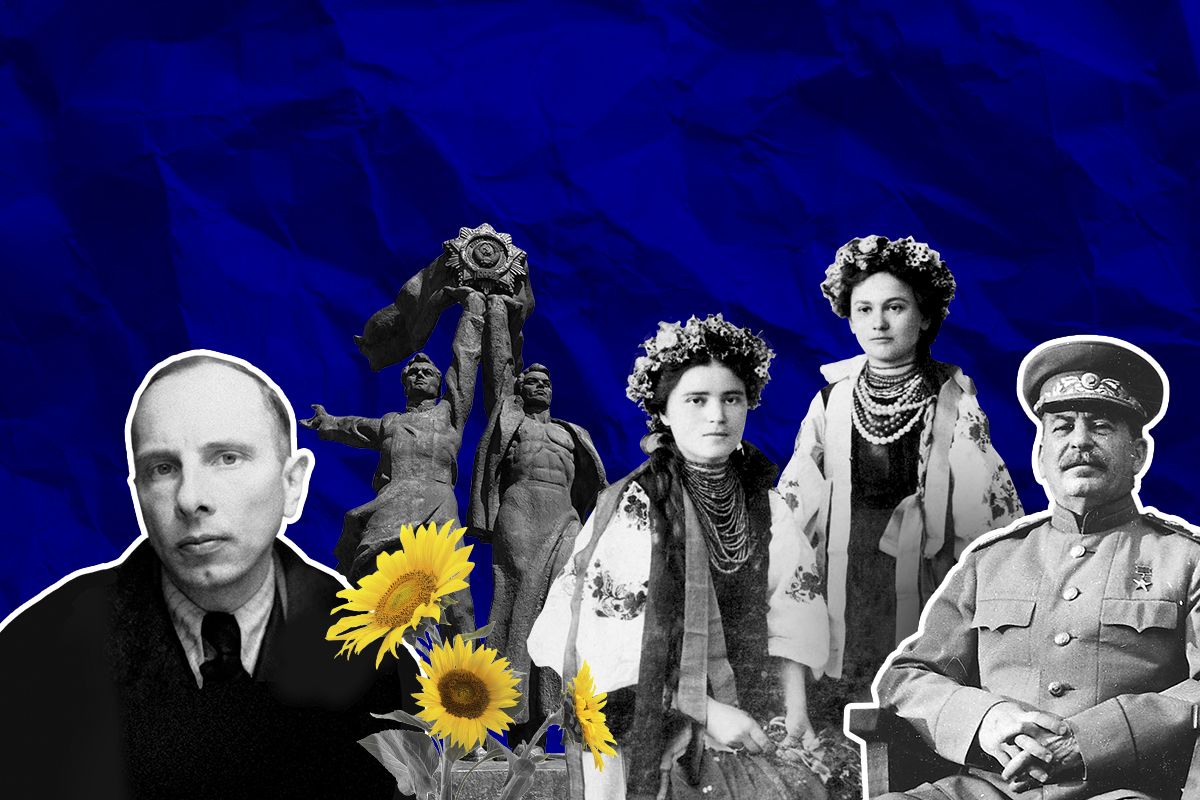How Russia steals and rewrites Ukrainian history to justify its claims in Ukraine

Appropriating and rewriting foreign history has been a key aspect of Russia's imperialist narratives.
This is especially true about the history of Ukraine, which Russia has sought to subjugate for centuries.
Crediting Russia as being the sole successor of the medieval Kyivan Rus and laying claims to all of the lands it controlled, erasing histories of Ukrainian cities such as Kharkiv and Odesa and justifying attacks on them while also labeling artists and scientists who lived in Ukraine as being actually Russian is part of Moscow's ongoing quest to erase Ukraine, its history and culture.

"They can't exist without stealing history from other peoples," Vadym Poznyakov, an activist who spearheads a campaign to dismantle monuments to Russians in Ukraine, told the Kyiv Independent. "They can't exist without Ukrainian history."
This imperialist way of swallowing neighboring countries and rewriting their histories has been part and parcel of Russia's attempts to justify its aggression against Ukraine for centuries.
Russia's recent annexation of Ukrainian territories, as well as the methodical brainwashing of Ukrainians in occupied regions and foreign observers covering the war to believe that Russia has a justification for annexation and murder, has been ongoing for many years.
Taras Honcharuk, a historian based in Odesa, told the Kyiv Independent that Russian dictator Vladimir Putin is using this narrative about "historic Russian lands" and ethnic Russians in Ukraine in the same way as Adolf Hitler used his narrative about "Greater Germany."

Russia's mythical Kyivan Rus
A lot of Russian historical narratives revolve around Kyivan Rus, a state that existed in the territory of modern-day Ukraine, Russia, and Belarus in the 9th to 13th centuries.
In Russian historiography, the Kyivan Rus is often portrayed as the forerunner of what would become Russia, while Ukraine and Belarus are depicted as marginal offshoots of this medieval state. Russian rulers are portrayed as the direct successors of the princes of Kyiv – such as Volodymyr I, Yaroslav the Wise, and Volodymyr Monomakh.
Rus, a word of Scandinavian origin, initially meant the whole territory of Kyivan Rus, but later Russia monopolized the use of the words "Russky" (an inhabitant of Rus) and Rossia (the Greek version of the word "Rus").
This allowed Russia to claim the mantle of the only legitimate successor of the Kyivan Rus and, thus, all of its territories.
In fact, the Kyivan Rus was an entity founded by the so-called Varangians (Scandinavian people, speakers of Old Norse) and populated mostly by Slavic, Baltic, and Finno-Ugric tribes. It gave rise to the Ukrainian, Belarusian, and Russian nations and languages.
The core territory of the Kyivan Rus was in modern-day northern Ukraine. One of the successors of the Kyivan Rus – the Principality of Galicia-Volhynia (in modern-day Ukraine) – was competing with the Principality of Vladimir-Suzdal (in modern-day Russia) for predominance in the 13th to 14th centuries.
Another successor of the Kyivan Rus was the Grand Duchy of Lithuania, which was ruled by a Lithuanian elite but dominated by the Ruthenian (Old Ukrainian/Belarusian) language and culture in the 14th to 16th centuries.
The Grand Duchy of Lithuania was a Westernized and more liberal alternative to the Grand Duchy of Moscow's despotism.
Starting from the 14th century, Ukraine and Russia have gone their separate ways, witnessing the development of separate languages, cultures, and histories.
Determining who exactly is the main modern successor of the Kyivan Rus is difficult – but some historians argue that it's either all three East Slavic countries – Ukraine, Russia, and Belarus – or none of them.
Malorossia – a case study of derogatory naming
Starting from the 14th century, Russia used the term "Malorossia" (Little Russia) to refer to Ukrainian territories. Russia itself was referred to as "Velikorossia" (Great Russia), and Belarus meant "White Russia."
Although the term "Malorossia" or "Little Rus" initially meant just a geographically smaller offshoot of the Kyivan Rus, it became part of Russian imperial discourse and a derogatory term signifying Ukraine's colonial status vis-a-vis Russia.
The term Malorossia went out of use after the collapse of the Russian Empire in 1917. Currently, Russian imperialists are trying to revive this term.
Another term often used by Russian propaganda is Novorossia (New Russia), which refers to southern Ukraine. The term emerged in the 18th century when the Russian Empire annexed this territory.
Historically this territory had been known as Desht-i-Qipchaq, or Dyke Pole (Wild Fields), and had been populated first by numerous Iranian and Turkic peoples, Greek colonists, and later Crimean Tatars and Ukrainian Cossacks.
The Zaporizhian Sich, a Cossack republic, was located along the lower Dnipro River in the 16th to 18th centuries.
However, Russian propaganda overlooks these ancient layers of history and portrays this territory as "historic Russian land."
Russian imperialists – such as Igor Girkin, the Russian intelligence officer who helped launch the invasion of Ukraine's Donbas in 2014 and was found guilty of downing the MH17 passenger plane – have claimed that so-called "Novorossia" and "Malorossia" are "historically Russian."
They have routinely used the terms "so-called Ukraine" and "former Ukraine" to refer to the Ukrainian state.
The not so 'historically Russian' Odesa and Kharkiv
Odesa, Ukraine's largest port city, has been a cornerstone of the Kremlin's imperial narrative. Russian propaganda has long claimed that Odesa is a historically Russian city.
In reality, it's much more complicated.
Ancient Greeks founded the first settlements in the territory of modern-day Odesa in the sixth century B.C.E.
In the 14th century, the town of Hadzhibey was founded in the same territory. The Golden Horde, the Grand Duchy of Lithuania, and the Crimean Khanate ruled it. In 1764, the Ottoman Empire also built the fortress of Yeni-Dunya in Hadzhibey.
Russia tends to ignore the history of cities before their annexation by the Russian Empire.
"They believe that the date of a city's foundation is when Russia came there," Odesa-based historian Honcharuk told the Kyiv Independent. "But cities in southern Ukraine were founded in the places where Tatar and Zaporizhian Cossack settlements had existed."
Moreover, Odesa has been developed by numerous ethnic groups.
After Russia conquered Hadzhibey in 1789, a new city called Odesa was built there by a multicultural team, including Jose De Ribas, an Italian-born officer of Spanish-Irish descent, and Francois de Wollant, a Flemish engineer.
The Duke of Richelieu, the future French prime minister, ruled Odesa as governor in 1803-1814. He is credited with Odesa's transformation into one of the empire's biggest and most advanced cities.
In the 19th century, Odesa was a multicultural melting pot, with Ukrainians, Russians, Greeks, Italians, French, Germans, Poles, Jews, Albanians, Bulgarians, and Moldovans living side by side.
By 1939, the Jews became the largest ethnic group in Odesa, accounting for 33 percent of the population.
Ukrainians have also played a major role in Odesa's history.
Zaporizhian Cossacks raided the Black Sea coast many times in the 16th to 18th century and captured Hadzhibey jointly with Russian troops in 1789. Currently, ethnic Ukrainians form a majority in Odesa.
Russian propaganda has also argued that Kharkiv has always been a Russian city. According to this version, Kharkiv was founded by Russia in the 17th century.
However, long before the modern city of Kharkiv emerged, Alan, Khazar, Cuman, and Slavic cities existed in and near Kharkiv from the 8th through 13th centuries.
When the Russian Tsardom built the Kharkiv Fortress in the 17th century, Kharkiv became a key center of Sloboda Cossacks – Ukrainians who moved from western Ukraine to the territory of modern-day Kharkiv Oblast.
Kharkiv-born activist Poznyakov argued that Kharkiv has had a rich Ukrainian cultural tradition, with many Ukrainian writers and artists.
He dismissed Russian imperialists' argument that Kharkiv is a Russian city as absurd.
"There was a large Jewish community in Kharkiv," he said. "But nobody is saying that Kharkiv should be part of Israel."
Kharkiv is considered the birthplace of modern Ukrainian theater, with the avant-garde Ukrainian Berezil Theater being founded by director Les Kurbas in Kharkiv in 1922. The theater was closed by the Soviet regime in 1933, while Kurbas was executed in Sandarmokh during Russia's Great Terror.
Ethnic cleansing in Crimea
Another favorite myth of Russian propaganda is that Crimea is a "historically Russian land." It has been used to justify the illegal annexation of the peninsula in 2014.
The myth is partially based on the fact that ethnic Russians currently form a majority in Crimea.
Like in other cases, the history of Crimea is much more nuanced than Russian mythology.
Crimea had been populated by Cimmerians, Scythians, Sarmatians, Greeks, Goths, Italians, Armenians, and various Turkic tribes for thousands of years before the Russian Empire annexed it in 1783.
The Greeks, who have lived on the peninsula since the 7th century B.C.E., dominated it much longer than Russia. However, Russia eventually erased the peninsula's Greek legacy.
After occupying Crimea in 1774 and before formally annexing it in 1783, Russia forcibly deported most of the Greeks living in Crimea to the territory of modern-day Donetsk Oblast.
Russia claimed that it was protecting Greek Christians from Muslim Tatars and Turks. But many Greeks resisted the deportation, and some even had to convert to Islam to escape the resettlement.
The Soviet Union later continued this policy, launching a wave of repressions against Soviet Greeks in 1937-1938 and deporting many of the Greeks living on the Black Sea coast, including Crimea, to other parts of the Soviet Union in the 1940s.
Crimean Tatars were another nation that had settled in Crimea before the Russians.
The Muslim Crimean Khanate, with a majority Crimean Tatar population, controlled the peninsula from the 15th until the 18th century. It was a vassal of the Ottoman Empire.
The Crimean Tatars remained the largest ethnic group in Crimea until the late 19th century, accounting for 35.6 percent of the population in 1897.
But – just like with the Greeks – the Russian Empire and the Soviet Union tried to erase the Crimean Tatar legacy.
In 1944, the Soviet leadership accused the entire Crimean Tatar nation of collaborating with the Nazis and deported around 190,000 Crimean Tatars from Crimea to other parts of the Soviet Union, mostly Uzbekistan. Tens of thousands died as a result of the harsh conditions of the exile.
Crimea was transferred from the Russian Soviet Federative Socialist Republic, a constituent part of the Soviet Union, to the Ukrainian Soviet Socialist Republic in 1954.
The peninsula became an internationally recognized part of Ukraine in 1991, with Russia recognizing it to be part of Ukraine under the Budapest Memorandum in 1994 and under bilateral treaties in 1997 and 2003.
This did not prevent Russia from illegally annexing Crimea in 2014.
Cultural figures and monuments
Russia also has a tendency to consider anyone who has anything to do with the Russian Empire or the Soviet Union to be Russian.
Russia has appropriated writer Mykola Gogol as one of the main representatives of classical Russian literature, based on the fact that Gogol lived in St. Petersburg and wrote in Russian.
The reality is more complicated: Gogol was an ethnic Ukrainian born in Sorochyntsi, a village in modern-day Ukraine, and most of his books were set in Ukraine and about Ukraine.
Writer Mikhail Bulgakov is also a complicated case. He is usually considered a Russian writer because he wrote in Russian and lived in Moscow during the latter part of his life. Moreover, he is often accused of having been a "Ukrainophobe" since he sympathized with Russian imperialism and was an opponent of the Ukrainian People's Republic, a Ukrainian state founded during the Russian Civil War of 1917-1923.
However, Bulgakov was born in Kyiv and lived there during the first part of his life, and some argue that he can be considered to be part of Ukrainian culture.
Serhii Korolov, the engineer who led the Soviet Union's space program and sent the first man to space in 1961, is also often considered to be Russian. However, he was born in the Ukrainian city of Zhytomyr, and his mother was Ukrainian.
Igor Sikorsky is also usually considered to be a Russian aviation engineer.
However, he was born in Kyiv and studied and worked in Kyiv, where his first planes were built. Sikorsky, then 30 years old, emigrated to the U.S. in 1919, where he founded the Sikorsky Aircraft company. He never visited the Soviet Union.
From officials to individual activists, Ukrainians have been campaigning to spread awareness about the nuances of the national identification of cultural figures who lived in Ukraine.
As a result, museums across the world have recognized Kyiv-born Kazimir Malevich, Kharkiv Oblast-born Illia Repin, and Mariupol native Arkhip Kuindzhi, among others, as Ukrainian rather than Russian artists.
Russia is also using monuments to Russian cultural figures as a tool in its imperialist expansion. As a result, there used to be thousands of monuments to Russians in Ukraine, with the most widespread ones being Soviet dictator Vladimir Lenin and writer Alexander Pushkin.
However, Ukraine began a campaign to dismantle monuments to Lenin and other communists after the 2014 EuroMaidan Revolution and a drive to get rid of monuments to other Russians after the start of Russia’s full-scale invasion in 2022.
“Monuments are a marker of the Russian world,” Poznyakov said. “They are used to identify ‘Russian’ territory.”
















